Game-based learning platforms have become popular tools to engage students through quizzes and interactive activities. In this comparison, we examine Blooket vs Kahoot vs ClassPoint: three distinct platforms that turn classroom quizzes into fun learning experiences.
We provide an overview of each platform, then break down key features, including game modes, question types, engagement, ease of use, and integrations to see how each one performs. We highlight a clear winner in each category based on factual, up-to-date information.
👉 But before diving into the details, here’s a quick TL;DR table that summarizes how the three platforms stack up against each other:
| Feature | Blooket | Kahoot! | ClassPoint | Winner |
|---|---|---|---|---|
| Game Modes | 15+ unique mini-games with varied mechanics | Single quiz-show style with a few variants | Embedded quizzes, no external game themes | Blooket |
| Question Types & Flexibility | Multiple-choice, true/false | Multiple-choice, true/false, puzzles, polls, open-ended (in paid tiers) | Multiple-choice, polls, open-ended, fill-in-the-blank, drawing, media uploads, audio | ClassPoint |
| Student Engagement | Highly gamified; avatars, power-ups, replay value | Fast-paced competition with music, countdowns, leaderboards | Subtle but steady; stars, badges, embedded into slides | Blooket |
| Ease of Use | Simple hosting, but some modes need explanation | Very intuitive; familiar PIN join method | Seamless inside PowerPoint, no app-switching | ClassPoint |
| Integration & Compatibility | Browser-based, works on all devices; no integrations | Broadest reach: browsers, apps, Google Classroom, Teams, LMSs | PowerPoint add-in, works with Zoom/Teams; no LMS integration | Kahoot! |
Now, let’s look at each platform more closely.
Platform Overviews
Blooket
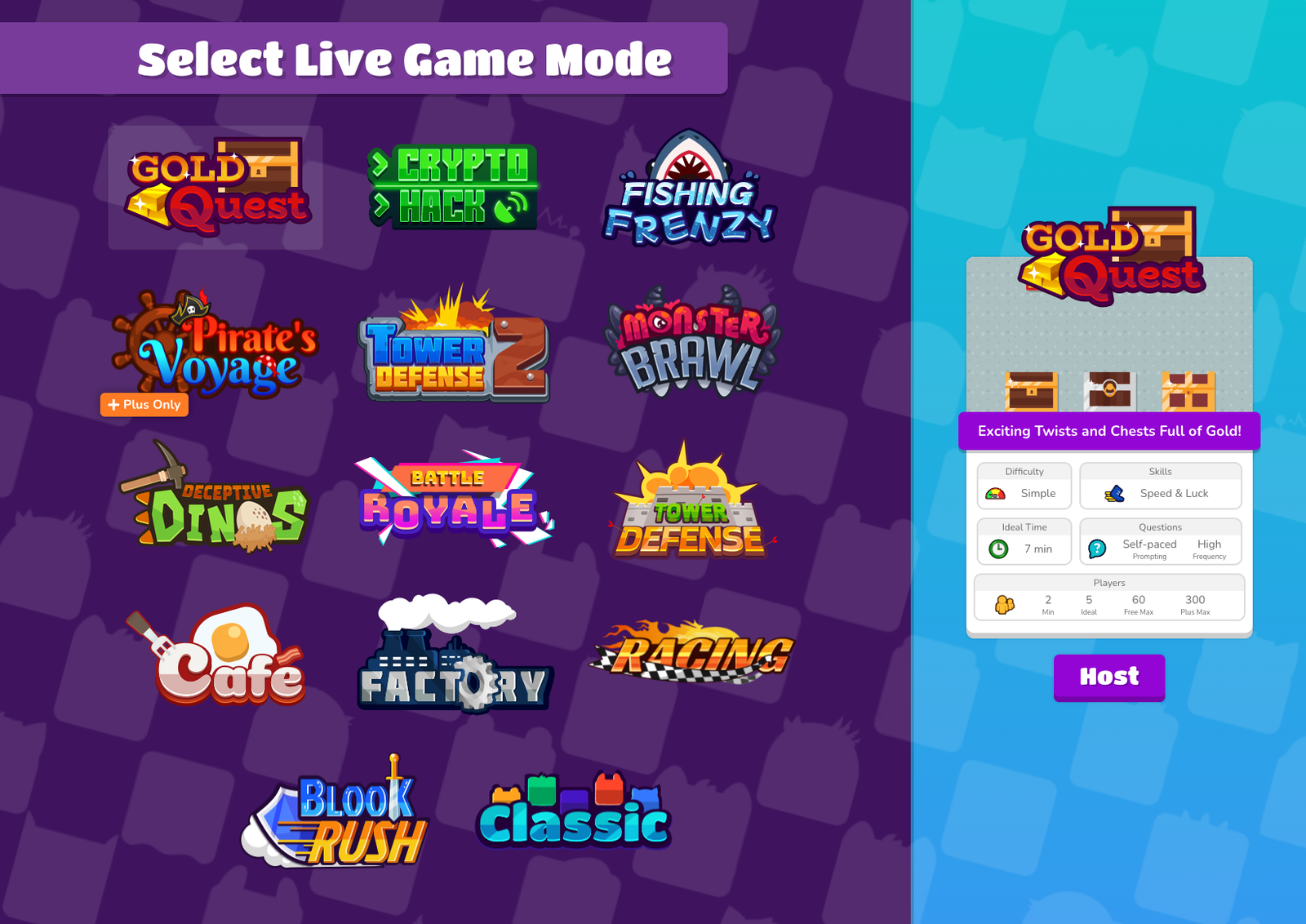
Blooket is a web-based game learning platform that transforms quizzes into playful mini-games. Teachers host question sets that students answer to compete in various game modes.
Blooket’s focus is on making review feel like a game: students earn points or tokens in-game, and some modes even encourage strategic thinking and teamwork as students discuss tactics.
The platform is easy for students to join (via a game code on any device’s browser) and runs self-paced in many modes, allowing each student to progress at their own speed.
Kahoot!
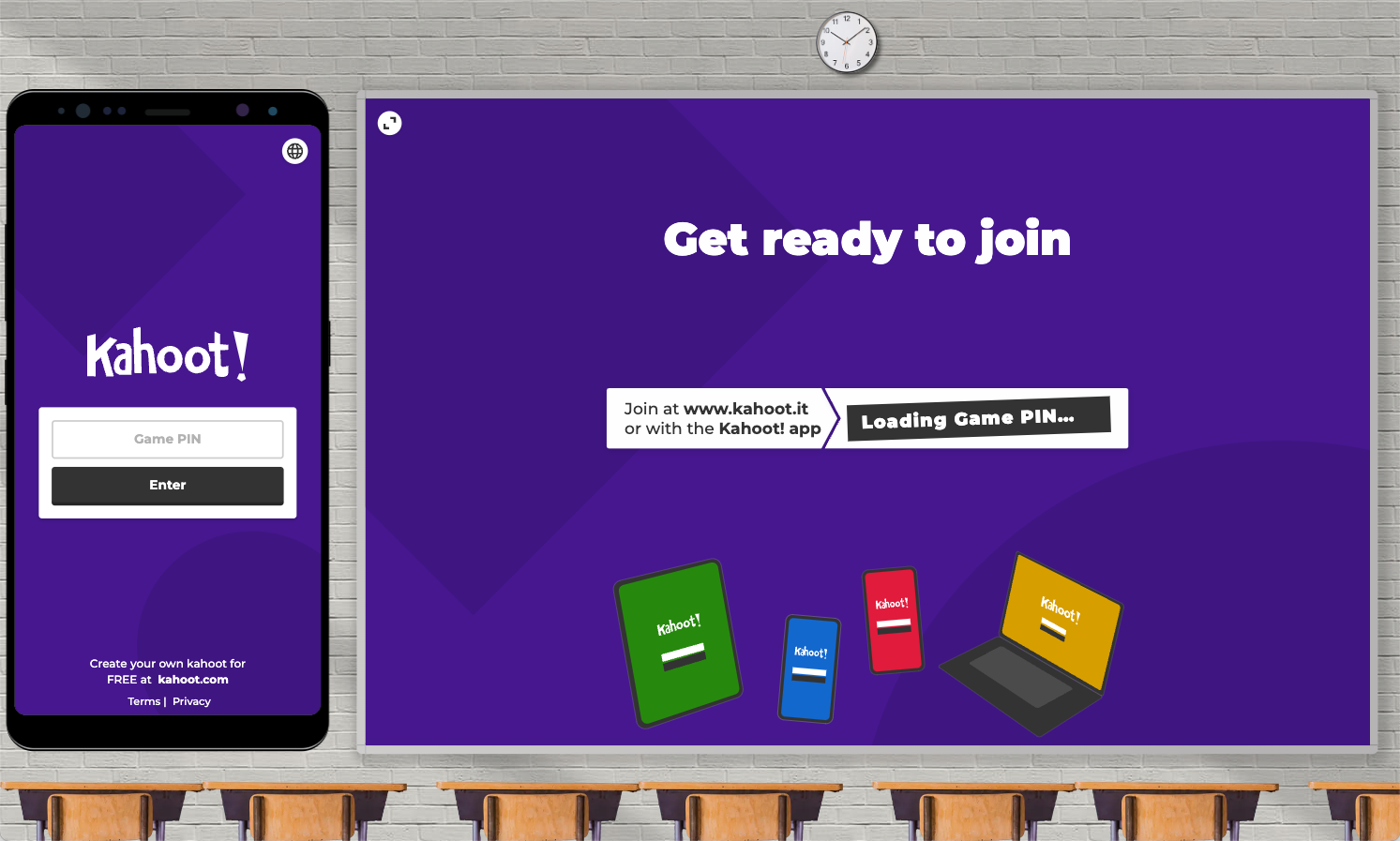
Kahoot! is the classic and widely-used quiz show platform that introduced game-based quizzing to many classrooms.
Teachers project multiple-choice or true/false questions, and students use a phone, tablet, or computer to respond in real time, racing against a countdown timer.
Kahoot’s gameplay is fast-paced and high-energy with upbeat music and a colorful leaderboard after each question that create a game-show excitement that motivates students to participate. Even usually quiet learners often get swept up in the competitive fun of trying to climb the podium.
ClassPoint
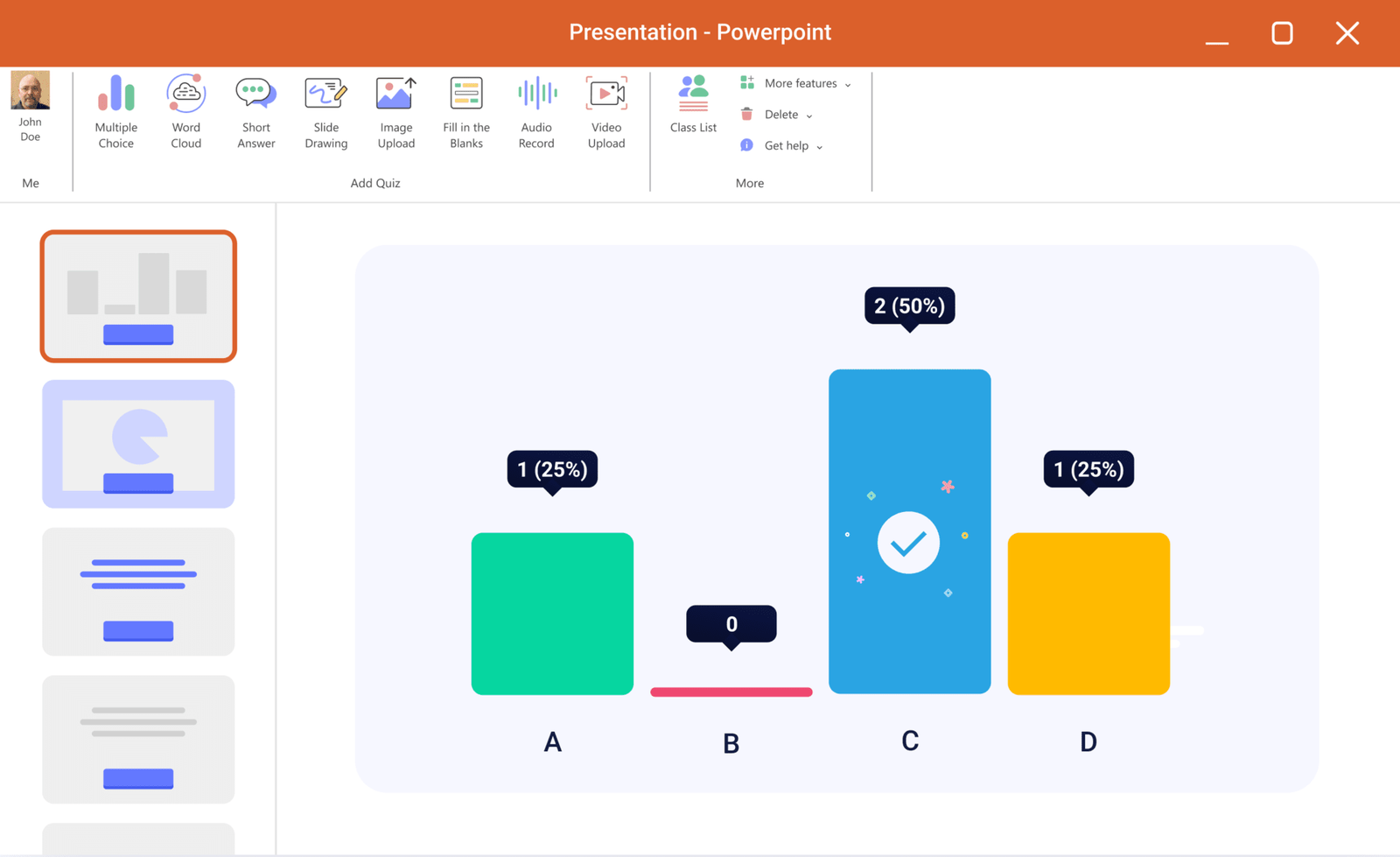
ClassPoint is a different approach: it’s an add-on for Microsoft PowerPoint that brings interactive quiz features directly into your slide presentations.
Once installed, ClassPoint lives in the PowerPoint ribbon, so teachers can present lessons as usual and seamlessly drop in questions without switching apps.
Essentially, PowerPoint becomes a two-way student engagement platform: a teacher can go through lecture slides and then, on any slide, ask a question that students answer in real time on their own devices.
Game Modes and Gameplay Experience
How do these platforms approach gameplay? This is where Blooket and Kahoot diverge greatly, and ClassPoint takes yet another route.
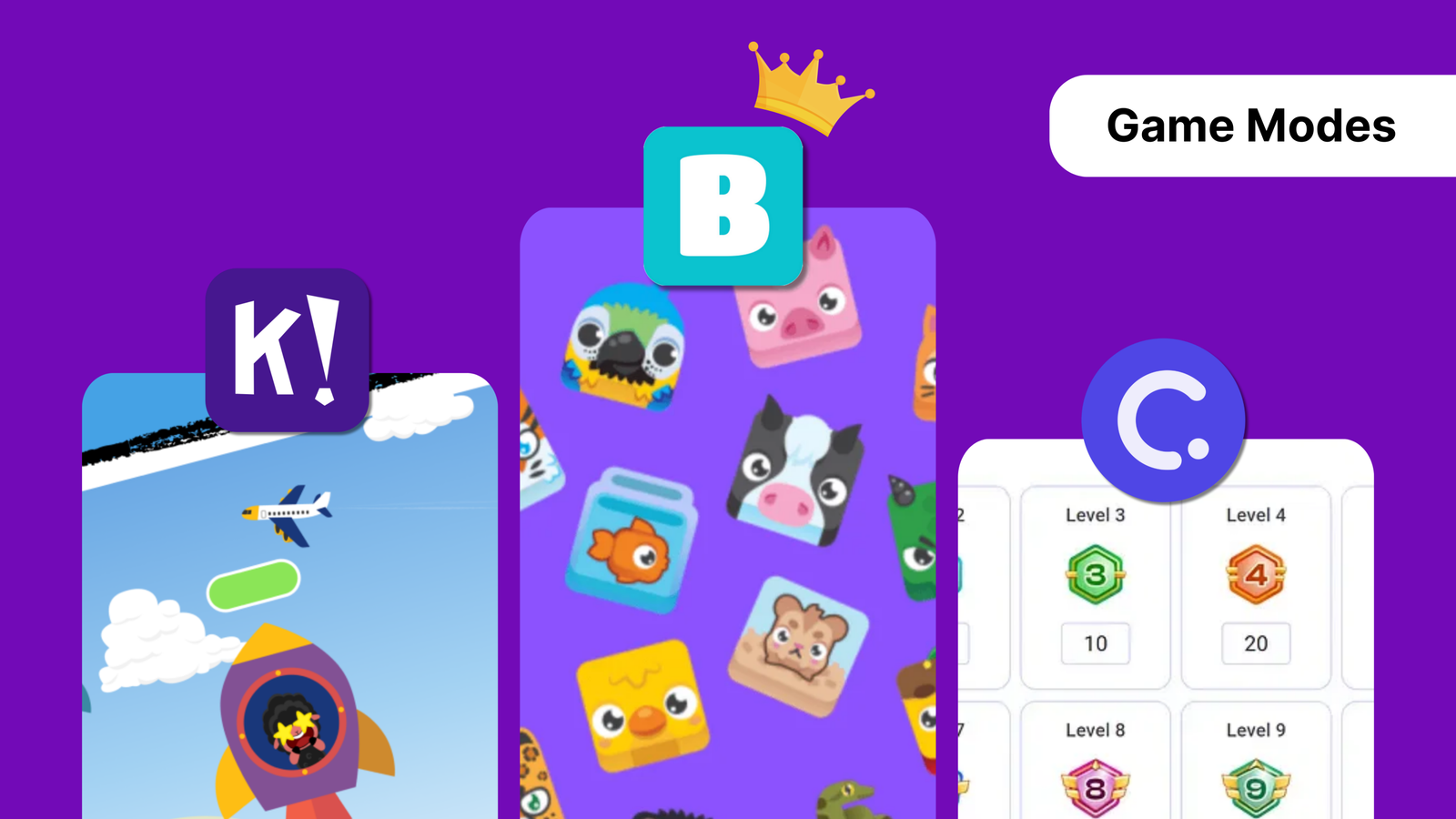
- Blooket stands out by offering rich game modes that go beyond standard quizzes. It has over a dozen distinct mini-games (like tower defense, factory simulations, café time-management, battle royale, etc.) layered on top of quiz questions.
Students still answer questions, but after each question, a fun game mechanic plays out, keeping students excited and often allowing continuous play at their own pace.
- Kahoot!, by contrast, uses essentially one game format: a fast-paced quiz show where everyone answers the same question simultaneously and points are awarded for correctness and speed.
Kahoot has added a few variants like team mode and puzzle questions, which add slight twists, but these are variations on the core quiz concept, not entirely different games as in Blooket.
- ClassPoint does not use any external game themes; the “game” is simply a question embedded in your slide, though it adds a competitive edge through a live leaderboard and rewards (stars) for correct answers.
There are no animated characters or mini-game visuals in ClassPoint, as the quiz stays within the context of your slide content.
For pure gameplay variety and excitement, Blooket is the clear winner in this category. Its multiple game modes make each session feel new and can be especially thrilling for students who enjoy video game-style rewards.
Kahoot provides a tried-and-true competitive quiz experience but can become repetitive, while ClassPoint’s gameplay is the most straightforward (focused on content more than game elements).
🏆 Winner: Blooket for game mode variety.
Question Types and Content Flexibility
Question formats determine what kind of learning content you can deliver.
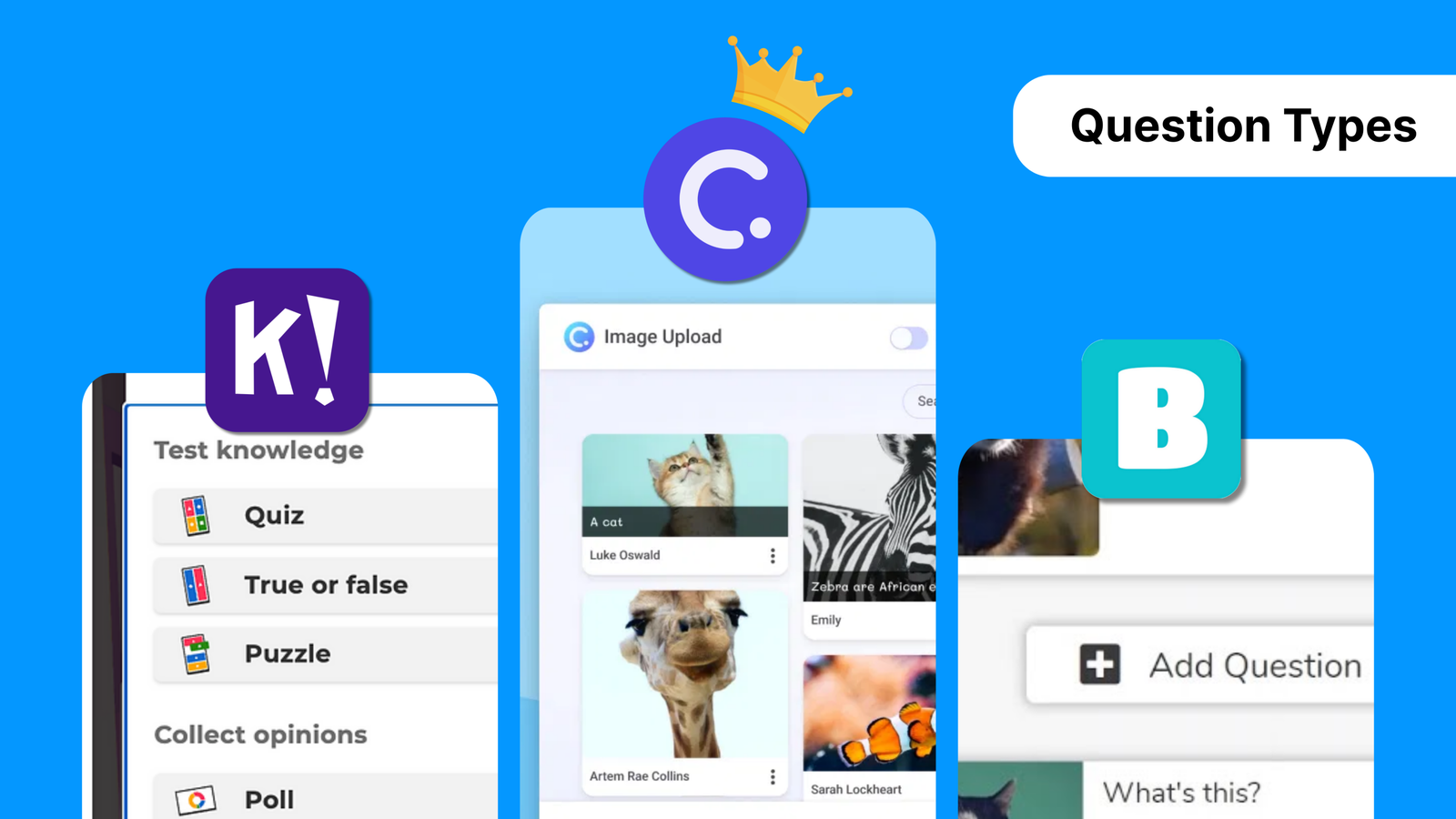
- ClassPoint leads in this area by combining both traditional and non-traditional formats. Teachers can use multiple-choice, open-ended responses, polls, and fill-in-the-blanks, while also unlocking unique formats such as:
- Slide drawing and annotation directly on visuals
- Media uploads, like images and short videos
- Audio recordings for oral practice or language learning
- Kahoot! offers a broad set of quiz features, particularly in its paid tiers. Teachers can create multiple-choice and true/false questions, sequence puzzles, open-ended prompts, polls, and more. It’s versatile and polished, but tied to a single game-show format.
- Blooket is straightforward with multiple-choice (and true/false) questions. Its strength is in pairing those questions with fun game modes, not in question variety.
Beyond variety, ClassPoint’s real strength is flexibility. Because it works inside PowerPoint, teachers can seamlessly integrate questions into existing slides, adapt them during lessons, or use pre-made quiz slide templates to save time. This contextual control makes ClassPoint highly adaptable across subjects and teaching styles.
Taken together, ClassPoint goes beyond question types alone by letting teachers embed them naturally into the flow of a lesson. This makes it not just diverse, but also flexible enough to fit any teaching style.
🏆 Winner: ClassPoint for its combination of diverse formats and unmatched flexibility within existing lessons.
Student Engagement and Gamification
Engaging students is the core goal of these tools, and each does so differently.
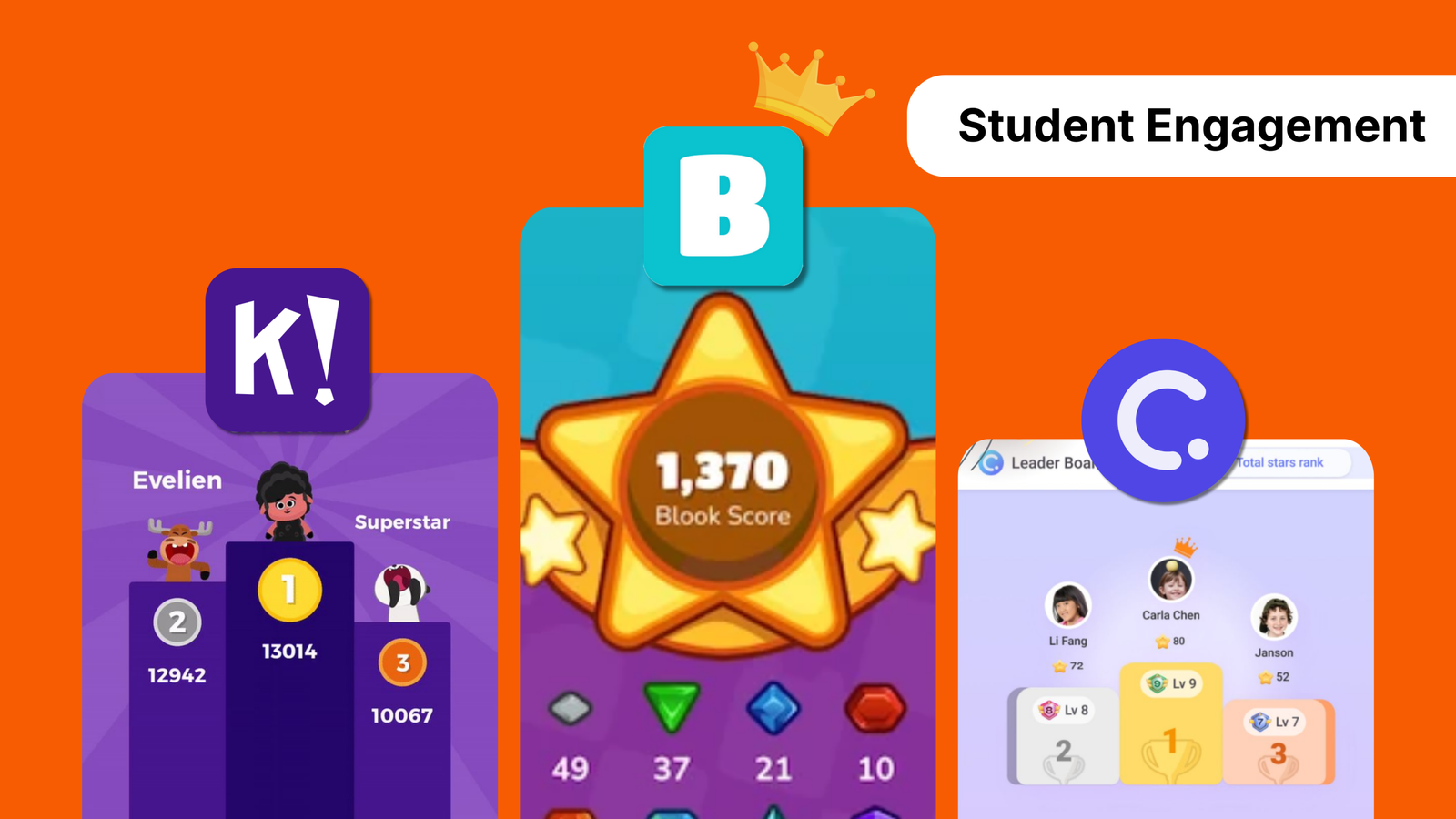
- Blooket’s bright cartoon themes, power-ups, and collectible avatars (“Blooks”) keep students highly motivated. They often don’t even realize they’re reviewing content because they’re so focused on winning coins or beating a level.
Many of Blooket’s game modes encourage replay and strategy, which can lead to collaborative chatter about tactics (a form of learning engagement in itself).
- Kahoot’s engagement comes from live competition and urgency: countdown timer, dramatic music, and instant feedback (points and the leaderboard) after each question. Students get very invested in their ranks. Even older students and adults often feel the thrill of Kahoot competitions.
Kahoot is also highly social; typically the whole class is focused on the same big screen, cheering or groaning together at the results, which builds a lively atmosphere.
- ClassPoint offers a more subtle form of engagement. Because it’s integrated into a lesson, students stay attentive knowing that at any moment a quiz question or poll might appear on the slide.
The gamification elements in ClassPoint (stars, levels, badges) reward students for participation over time, which can motivate them to answer questions thoughtfully.
For pure fun factor and student excitement, Blooket is arguably the winner, especially for elementary and middle school ages, as it feels like playing a game, so students are extremely enthusiastic.
🏆 Winner: Blooket for highest student engagement through gamified fun.
Ease of Use and Setup
All three platforms aim to be teacher-friendly, but their contexts differ.
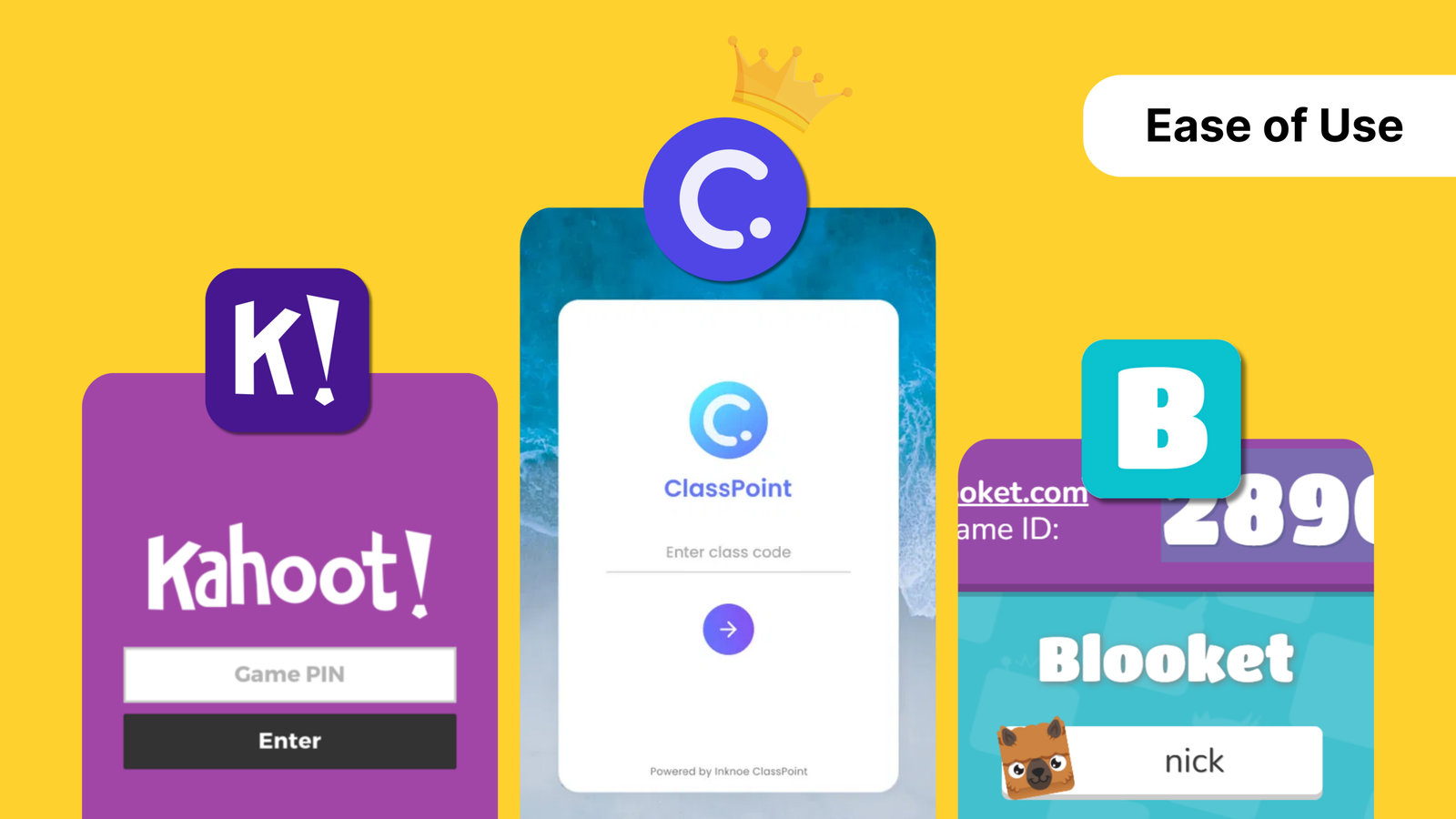
- ClassPoint stands out for its seamless integration into the teaching tools educators already use. Since it lives directly inside PowerPoint, there’s no need to switch between apps or manage multiple platforms.
Adding a quiz is as simple as clicking a button from the PowerPoint ribbon, and presenting continues as usual. Teachers can prepare questions in advance, drop in quiz templates, or even create them on the fly during a slideshow using its built-in AI quiz generator.
For students, joining is just as easy: enter a class code on classpoint.app and respond directly.
- Kahoot! is widely recognized for simplicity: creating a quiz takes minutes, and students join by entering a PIN on their devices. However, it functions as a separate platform, which requires switching away from lesson slides to host a game.
- Blooket also offers a straightforward setup. Teachers can quickly select or create a question set and choose from various game modes. Students join with a code, though teachers may need to explain game mechanics the first time. Its interface is simple, but the variety of modes means a few extra steps compared to Kahoot.
While Kahoot and Blooket are both easy to adopt, ClassPoint’s biggest advantage is that it doesn’t disrupt teaching flow. For educators who already prepare slides, its integration makes quizzes feel like a natural extension of the lesson.
🏆 Winner: ClassPoint for its seamless, no-disruption setup within PowerPoint, giving teachers an all-in-one teaching and quizzing experience.
Integration and Compatibility
How smoothly each platform fits into classroom technology makes a big difference for teachers.
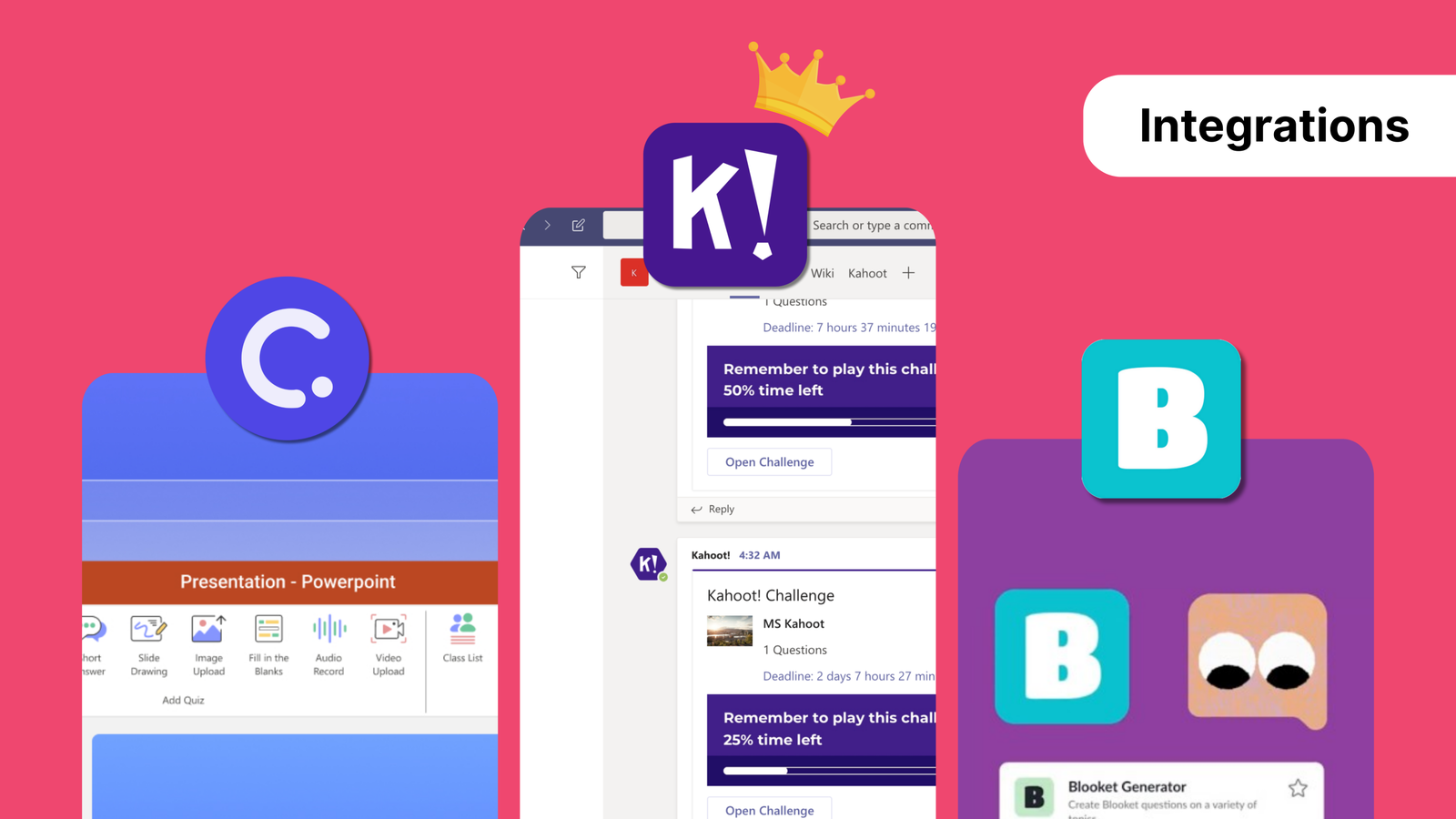
- Kahoot! leads here with the broadest reach. It runs on any browser, has dedicated iOS and Android apps, and integrates directly with Google Classroom, Microsoft Teams, and Apple Schoolwork. It can also be embedded into certain LMSs. Whether in-person or remote, Kahoot is cloud-based and easy to launch in nearly any environment.
- ClassPoint integrates seamlessly into Microsoft PowerPoint, making it perfect for teachers who already rely on slides. Students can join from any device via browser or app, and the tool works smoothly with video conferencing platforms like Zoom and Teams. Its main limitation is that it doesn’t connect directly to LMSs or rostering systems.
- Blooket is the most standalone. It’s browser-based, device-agnostic, and simple to share with a game code, but it doesn’t offer official integrations with default classroom platforms or LMSs.
Kahoot’s wide compatibility and direct integrations make it the most versatile option, while ClassPoint is excellent for PowerPoint-centered teaching and Blooket remains a self-contained game platform.
🏆 Winner: Kahoot for compatibility and integration.
Blooket vs Kahoot vs ClassPoint: Which Tool Wins?
All three platforms have their strengths, and the best choice depends on your classroom needs:
Blooket is best for:
- Game-based review and practice
- Wins on game variety and student engagement
- Perfect for exciting younger learners with fun, competitive play
Kahoot! is best for:
- The all-around classic
- Excels in ease of use, broad question types, and integration
- Great for quick formative checks and lively whole-class participation
- Reliable for nearly any age group or setting, from K-12 to professional training
ClassPoint is best for:
- Teachers who want to embed interactivity directly into lessons
- Ideal for those who regularly use PowerPoint
- Adds quizzes, polls, drawing, and media responses seamlessly into slides
- Enhances lectures with continuous engagement without disrupting teaching flow
In short, this Blooket vs Kahoot vs ClassPoint roundup is all about matching the tool to your teaching style, not declaring an overall winner.
- Blooket delivers the most playful game mechanics.
- Kahoot! balances versatility and simplicity.
- ClassPoint brings interaction and flexibility right into your presentations.
The good news is all three have free versions, so you can try each and discover which sparks the most engagement in your classroom.
